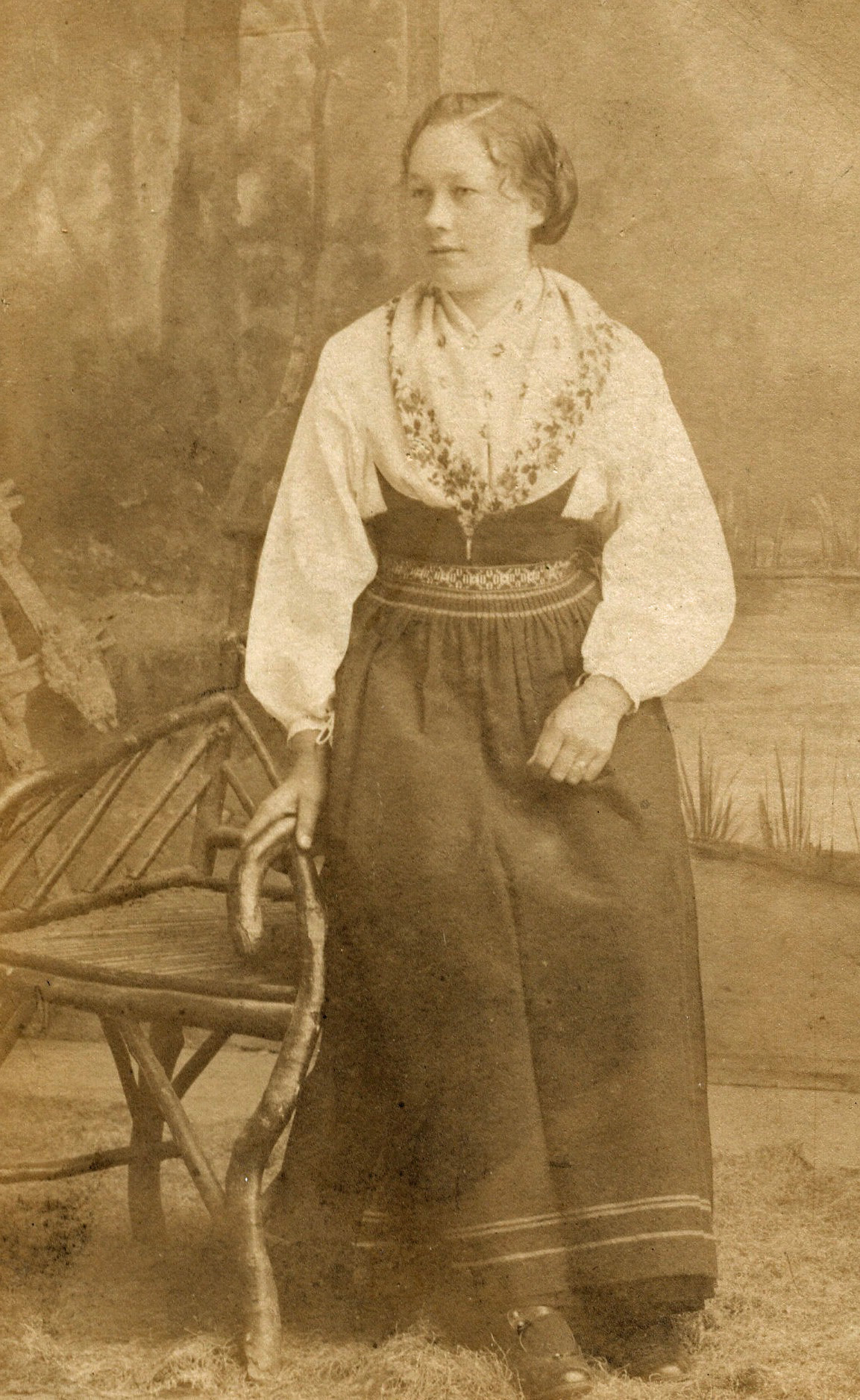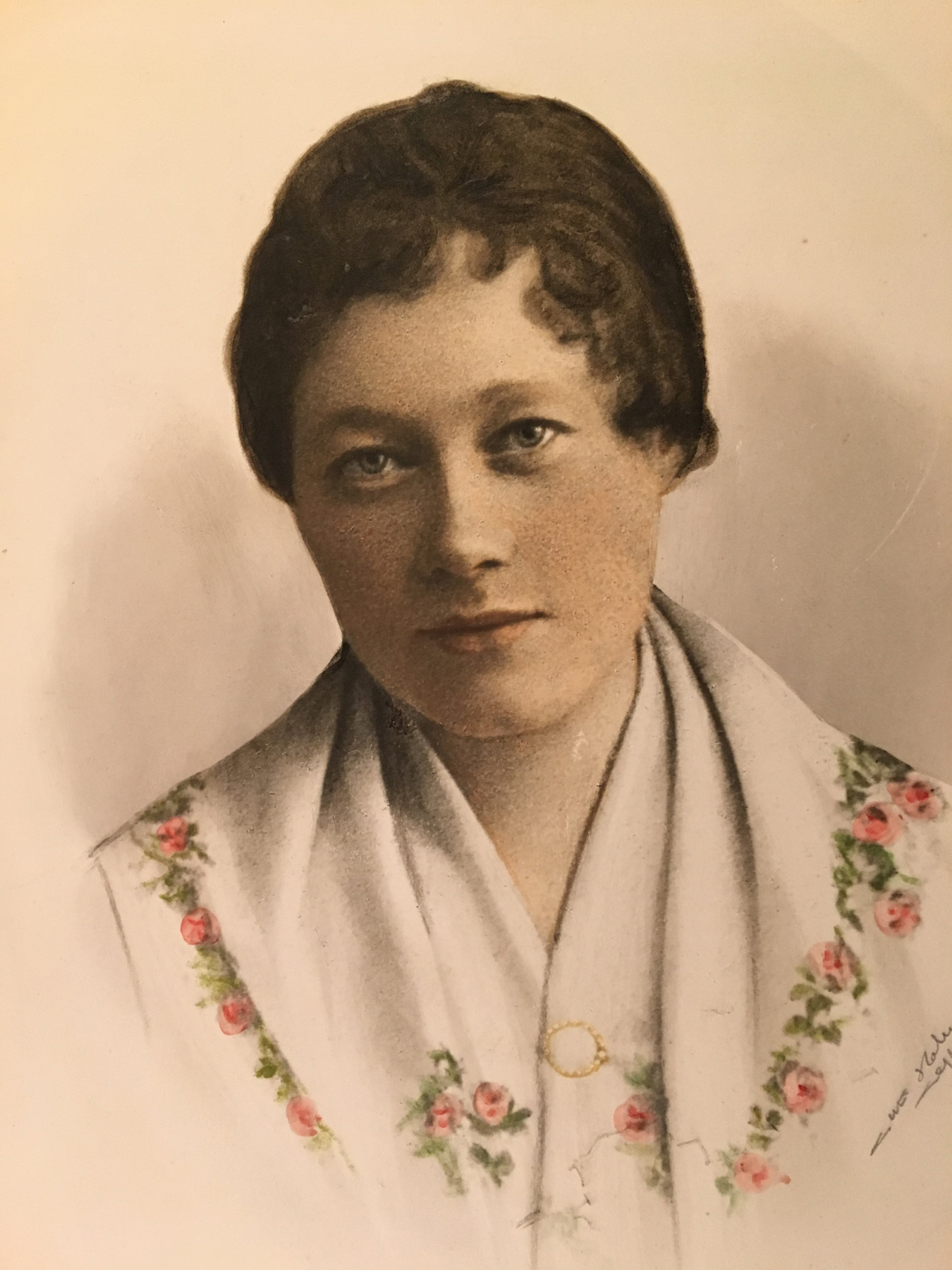
OLMATS ANNA KRISTINA ANDERSDOTTER (1900 – 1983)
I’ve always thought that I had the only Grandma in the world whose eyes would dance every time she smiled. She was the epitome of patience, love, and endurance. Anna Kristina Andersdotter was born February 18, 1900 in Färnäs, Mora, Kopparberg, Sweden, to Olmats Anders Andersson and (Sasser) Anna Persdotter. She had three brothers: Carl, Emil, and Anders…and 4 sisters: Maria, Karin, Margit, and Elsa. When Anna was 18 years old her mother died leaving her to nurture her brothers and sisters. She married Anders Magnus Magnusson 2 May 1920 and on 6 Nov 1923 she left Sweden to come to America with her two sons, Erik and Gunnar. She traveled with her cousin, Anna Wik, and her brother, Carl. Anders had preceded Anna to America via Canada on 6 Jul 1923 thru Harlem, Montana. (Their son, Erik died 19 June 1925 in Elma, Washington of appendicitis…he was just five years old.)
I loved hearing my grandmother sing softly to herself. She mostly spoke Swedish. Her hair was dark brown but I think she colored it occasionally to cover the grey. When she laughed it was almost like a shy giggle. Grandma always wore an apron with pockets in the front. She wore black rimmed glasses, wore soft blue nylon nighties and smelled like the pink face cream she always used from Merle Norman Cosmetics as well as Evening in Paris perfume which was one of her favorites. With our elbows on the dresser we would carefully watch with awe, every detail as in the morning she cleaned her face in front of the big dresser mirror in her bedroom, combing her hair and putting on her make up for the day. She would say she had to ‘put on her face’ in the mornings. She liked to have us “pin up” her hair which was using bobby pins to make pin curls. She was always so happy to have her hair fixed so she wouldn’t have to wear her hair net. When she was a young girl in Sweden she had a skiing accident and broke her hip. Because of that she always walked with a limp and always depended on a cane to help her walk. Grandma loved her homeland and missed her family back there. She did, however, travel back to Sweden several times for a visit. One thing she treasured was her traditional native Swedish costume. Typically, every girl learned to sew and make her own costume to be worn on special occasions and holidays. It had a beautiful green wool jacket, a colorful red bib-front with attached black pleated skirt, white embroidered blouse worn with a red hair ribbon, long red wool socks, a decorated long red apron and a brown leather pouch bag that hung from the waist. She also had a smaller child version that my mother wore for pictures when she was around two years old. Those same traditional folk costumes have been worn in our family by my sisters, my daughters, and my granddaughters [which would be Grandma’s granddaughters, great granddaughters, and great great granddaughters!] It has also been worn for photographs by even more family members over the years!
Of all the things I remember best about Grandma was that I knew with all my heart that she loved me and that I was special to her. She loved all her grandchildren – each of us felt this way. She taught me how to embroider…and how to crochet. Once she showed me how to take postcards and crochet them into a little box with a lid by crocheting along their edges after punching little holes around them. She also would save foil wrappers off of chocolates and wrap each and every single kernel of oats on a stem. That took a lot of time, and a whole handful of stems soon became a very pretty and colorful bouquet for her table in the living room. I loved sharing time together talking and working on projects with Grandma. She was so good with crocheting! She took her crocheting projects wherever she went. It seemed like it took her no time at all to crochet a tablecloth, doilies or a popcorn stitch bedspread….her work was heirloom quality. She would take her work to the fair in the summer and for months afterwards there would be a basket in the living room or kitchen on the table of all the fancy colored ribbons which we loved to play with and admire. She won them for her handiwork as well as her baking – Grandma was a wonderful baker! She was a wonderful Grandma! Her cookie ‘jar’ was a round, metal, three tiered container. Each section had the best cookies – some with a cherry in the center, some sprinkled with “perl” sugar, some with jam centers…spritz cookies, star shaped, some frosted! Her kitchen on baking day was filled with the smells of cardamom, sugar, cinnamon, and vanilla. From one batch of her Swedish bread recipe which she called “Bullar”, she made cinnamon rolls, loaves of braided sweet bread, twists, buns, and coffee cake rings. The cinnamon rolls she would make in heavy black frying pans, and she sugared the braided bread, frosted the twists pink, and used candied fruit in the coffee cake. It looked so effortless to see her rolling long strips for twists which she wrapped around her thumb into a figure eight to shape. We loved getting a little dough from her so we could practice and make them with her. For the coffee cake she would roll out the dough into a big rectangle – smooth on her homemade butter, put on brown sugar, cinnamon and dried fruit and roll it up in one long roll…which she joined together in a circle and placed on a cookie sheet. Then with scissors she would snip the roll going about ¾ of the way thru the roll, laying each cut piece gently on it’s side. There was even “Skorpor” – which was sliced Bullar from the braids. She would lay the slices on a cookie sheet and very slowly dry them in the oven….presto! Swedish Biscotti! We also loved the three colored molded Jello Grandma would make – it had bananas in one layer, sometimes shredded carrots, or even sometimes strawberries. She even taught us to dip lettuce in the sugar bowl for a treat – and dunk buttered toast into hot cocoa!
But it was Grandma’s Swedish pancakes that we all loved the most. When she made pancakes she had to make a big batch! You had to line up at the kitchen stove while she cooked the first one, then go to the table to put on the butter and jam and roll it up to eat. Meanwhile, the next person in line could hardly wait till theirs was done and the person behind them was eagerly waiting for their turn! By then, the first person had eaten theirs and was back in line! The line didn’t end till we all were as full as puppies including the adults! I remember in her kitchen there was a very long breadboard she would pull out of the counter to roll out her bread on…it even served as a table for lunch. Below it were large built-in bins for her flour and sugar. To the left was a cupboard she called the ‘cooler’ which had shelves in it and was vented to the outside with screens to keep butter and other perishables nice and cool [being that under the house the temperature was cooler than the outside temperature]. If she had hot food she wanted to cool she would put it in the cooler which would not only cool it down, but keep the flies away.
In the corner above the sink in the kitchen by the window was the medicine cabinet. One night Grandma wanted to rinse her mouth with mouthwash but accidentally grabbed a bottle of ammonia.
When she and Grandpa first moved to Gate and built their home there, she would bake bread and Mr. Brask, a neighbor, would take it around on his dairy delivery wagon and sell it for her. Without speaking English it was hard for Grandma to communicate –and how she managed with her small children I can’t imagine. Once she took meat back to the butcher because it was spoiled. Trying to explain why she brought it back and being frustrated by not having the right words to express herself, she held up the meat to him and told him to “stink it yourself “. My Mom and grandparents spoke Swedish together. As kids, we got pretty good at figuring out which words they said to indicate which one of us kids they were talking about! When we took Grandma to town to shop at J. C. Penneys, she would let me hold her “pocketboochie” [purse]; when she wanted Chico, their little black and white terrier to stop barking and go lay down she would tell him to, “go leggiday![lay down and be quiet]” We knew if she were speaking of my brother, she said “poijken”…which in her Swedish dialect [Dalsk] meant ‘boy’. She also said “uf da!” if she thought something was disgusting or ridiculous….But her most famous saying was “better out than in” – a saying that has continued in our family for yet three generations! I still smile when I remember two particular cards Grandma sent to me over the years …one had a really pretty floral arrangement on it and said, “Happy Birthday, Grandfather” printed on it….and the other was for my wedding….a beautiful card that read on the front, “With Deepest Sympathy”! Grandma was really good at picking out cards, but her English skills held her back a little!
Grandma got so excited for the annual Pillsbury Bake-off contest. During the year she would create new recipes and give them a new name. Like her Century 21 Cherry Donut Ring Cobbler. With every entry she submitted to the contest she would enclose a four- leaf clover she had found and pressed to dry in a book. Every time we were outside with Grandma she would use her cane to poke around in the grass glancing down to see if she could find a four-leaf clover to press. That’s where we as her grandchildren came in real handy. We would all be down close to the ground checking all the clover in the lawn ‘helping Grandma’ find that lucky clover! Ironically, one day Grandma did win a prize from the Pillsbury Bake-off Contest. She received a large leather bound, gold edged collection of recipes which was given to just the 10 top state winners. Maybe those four- leaf clovers did work!
It was almost too good to be true when once while Grandma and Grandpa were visiting us at our home in Black Lake, it was decided that I could go back home with them and spend a couple of days together with them – all by myself! I remember as the car pulled away from our house to leave…I had a toothbrush in my hand and a funny feeling about leaving home. But it was a chance of a life time and I was so happy for the experience. I must have been about 11 years old. Their home was heated only by a wood stove furnace in the living room corner. Grandpa would sit by its opened door leaning forward in his straight backed chair throwing in wood to keep it going. It got cold during the night. It wasn’t hard to snuggle down in my blankets on the couch when you could hear the coyotes mournfully howling in the night. That was scary! Grandpa said the coyotes were out over by the garbage dump way back behind their house and barn. Everything was so much better in the morning…but you didn’t dare get out of the covers until Grandpa built another fire and the house warmed up. I woke up smelling pancakes and bacon! Grandma even let me have orange flavored Tang to drink and we took our plates out on the porch to eat in the fresh morning air. It was the nicest porch to go out and sit on the wide ledges – in the morning you could hear the birds and see the cows grazing. The morning air smelled so fresh. In the hot afternoon sun it was great because the porch was shaded and the whispering tree breezes blew through and around it. It was a perfect place for hearing Grandma tell us stories about when and where she lived in Sweden. Even now, never actually having been to Sweden, I feel I have been there through my grandmother’s memories and stories – and I am content to always love the Sweden we shared together. Because she would tell us of her sisters and their children and all the people who were still back “Home”, I learned to love them and feel they are a part of my life even now.
Grandpa would drink his coffee in the morning by the fire. When Grandpa drank coffee, he would put a sugar cube [he called it ‘beet sugar’] between his lips…pour some coffee from his cup onto his saucer and sip the coffee from the saucer through the sugar cube. When Grandpa wasn’t sitting in the chair by the warm fire, Grandma sat there crocheting by the light coming in from the window. The floor in the home was linoleum with pink, green, ivory floral patterns. There was always the sound of the tall Mora clock that had been shipped from Sweden. It was a sentinel in the home and the sounds it made were comforting. On it were hand painted floral decorations on a brown stain background – very typical of the Mora clock industry famous in Mora parish. Off the living room were the two bedrooms. Between their doorways was a long dresser on legs with a pull out cupboard on each end. Above it was a mirror that made the living room look just a little bigger than it really was. Grandma kept a tea set and some pictures on the top with a crocheted doily running across it. Sometimes there might be a glass bowl or vase containing fresh flowers. Inside one of the drawers was a metal tin that contained a myriad of odds and ends, and it was the height of delight if we got permission to look inside it. For hours we would ‘discover’ marbles, old lipstick cases, buttons, bottles of fingernail polish, parts and pieces of whatever and things we could never even guess where they came from – it was just a treasure box and we loved it. The two foot tall painted Dala Horse and the small decoratively painted chest on spindle legs that came over from Sweden are also part of what was always in the living room.
Some times in the late afternoon, Grandma would lay down on her bed to rest and we loved to climb up beside her. She didn’t mind if we talked and talked – she was a good listener and storyteller.
We loved to explore and investigate the barn….the smell of the animals and hay…all the ‘stuff’ stored in it that was so curious! Sometimes there was a new calf or kittens. When Grandpa milked the cows he showed us how he would squirt milk at the cats and they would open their mouths to catch the warm stream. When Grandpa came in after milking the cow, Grandma would have the big silver filter ready for the milk to be poured into. She had white enameled pans with red trim edges. Once the milk was strained she poured it into pans to cool and then put it into gallon jugs. In the morning, resting on top of the milk would be about a third of a gallon of sweet thick cream. That would be skimmed off and poured into the glass butter churn that we got to take turns churning for what seemed to take forever to get it to ‘make butter’! Once the butter was all made you had to pour off the buttermilk for drinking and the butter was pressed and paddled in a wooden bowl under cold running water. A little salt was added to each yellow mound which was given a pattern on top of it with the underside of the wooden paddle and then wrapped with waxed paper. I think her butter was one of her best kept secret ingredients for her baking!
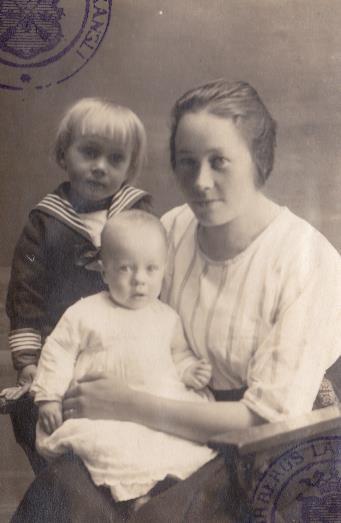
Grandma’s dishes and plates were beautiful…soft pink and maroon highlights on ivory backgrounds…I believe it was called the Apple pattern.
The kitchen area’s dining room table (swirling red and grey plastic top with silver metal legs) wasn’t just for eating on. Every morning and afternoon Grandma had it cleared and spread out with Bingo cards she had collected during the week from shopping at Fuller’s Market. Everything had to be in place and ready – buttons around each card to mark them with – the radio turned on and tuned to the right station where we usually caught the tail end of the Farm and Market Report before we heard it was time for “Radio Bingo!”
The announcer on the radio always reminding his listeners to “Make Your Market Basket a Fuller Basket! [at Fuller’s Market]” When the numbers began to be called, we all knew that it meant we had to be real quiet so no one would miss hearing any of the numbers… any infraction to this rule would mean banishment from the room and all the fun. We all felt that we were ‘helping’ Grandma and once or twice she even won!
The table was also where we would enjoy playing with a small set of wooden farm animals that had real little wooden fences to make corrals with…as well as some little people. We played for hours making pretend adventures. Grandma’s kitchen held a special coziness. People congregated there or passed thru it coming into the house at the back door on the way to the warmth of the living room. Looking out the window in the dining room you could see the clothesline and across the field see the train depot. The best part was that the window opened swinging outward…you could talk with anyone who was outside hanging clothes out on the clothesline to dry…or hear and see the train as it pulled into the depot. Also outside by the clothesline was a little cabin painted white with red and green trim that had been built for Grandma’s brothers Karl and Emil to use, equipped with a little kitchen and bedroom. It was fun to go inside and look around and see things that were stored inside after Karl and Emil no longer lived there.
Off the kitchen was the laundry room [across from it was a bathroom]…The laundry room had two big wash tubs connected to the wall with shelves up above them. Sometimes Grandpa would reach up high in a box on the shelf and choose a beautiful rock to give me that he had brought back from a trip to Bryce Canyon or some other place. I still have the one from Bryce Canyon. And I remember Karl cleaning clams in the sink with a knife. He was always with a smile trying to tease as he ate a piece of raw clam to make us run away in disgust to tell Grandma! The laundry room also had a huge white wringer-washing machine which Grandma would use to wash her clothes. She washed them first and then opened the wringer arm of the machine to be positioned over one of the wash tubs and as the wringers began to roll, she put all the clothes thru the wringers into the tub filled with hot rinse water. Then they would be put thru the wringer again and laid in a basket to be taken outside and hung on the clothesline in the sun. All the clothes smelled SO good and SO fresh after being dried outside. Grandma was so particular about her wash and used “bluing” to whiten her whites.
Gate was just a “speck-on-the-wall” sized town even back in the middle 50’s…a couple of railroad tracts that crossed over each other – both heading out of town. The Gate Depot served as a hub where mail was picked up, dropped off, or delivered….a place to meet as neighbors to catch up on the ‘latest’ news, have a cup of coffee while warming themselves by the fire. There was a family who actually lived in the depot. There were cubby holes for mail, a pot bellied stove, cement floor, and a couch to sit on while waiting for the trains. All the kids in the neighborhood when mom lived there went to a one-room school where the kids and teachers cooked their government lunch rations [mostly soup or beans] together on a big wood burning stove in the middle of the room. Their favorite swimming hole was called Big Rock. It was where in the middle of the Black river there was a huge bolder that was big enough to swim out to and climb on top of.
Walking from Grandma and Grandpa’s house to the depot to get the mail was a treat and a long walk on the gravel road. Plenty of time to go as slow as possible not to miss any of the little agates with which to fill your pockets, or just contemplate life while checking out all the cows, and flowers….hoping a snake would hurry across the road so we could go step on his tail to take a good look at it. One good thing about being there was that there was never any hurry….and with my pockets bulging with my precious agate finds, I would come home and put them in a jar Grandpa gave me to save them in. I remember so many times that the way I would go “get the mail” was to walk every single inch of the whole road up there…step by step…crisscrossing back and forth the entire way…my body bent over, my eyes glued to the ground…looking for little clear agates to put in my agate jar!
We loved the freedom we felt being at Gate. In the upper pastures there were huge, mean looking bulls. Grandpa used to buy them yearly from a farm down in Longview. If we could see that they were in behind the fences by the barn or in the barn, we would go thru the barbed wire fence and look for adventure as we roamed over the prairie, up and down the natural hilly mounds. The sun would be shining and the wind blowing and after a quick check for cow pies, we’d lie on the ground and roll down every mound we could in quick succession, one hilly mound after another. We would keep our eyes open for any golf balls that might have been hit over from the neighbor across the railroad tracks…he practiced his golf game from his porch and any balls we rescued for him he’d pay us a dime apiece to return them.
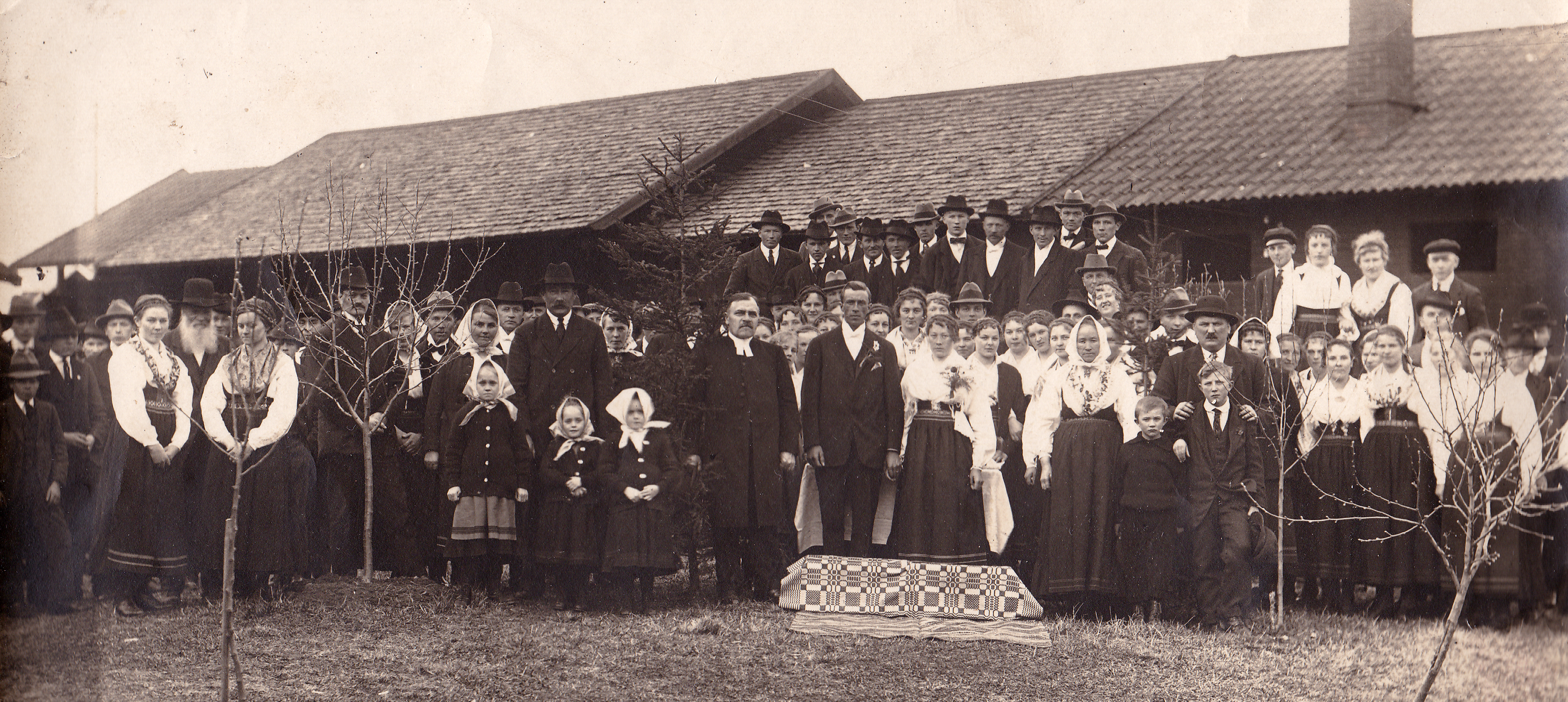
The woodshed and garage were right near the house and they were a never ending source of entertainment because they had all kinds of things to discover and investigate inside. At the entrance to the garage sat a big gigantic tree stump about four feet across. Mom said she use to help straighten used nails for Grandpa on it. There was a can of nails and a hammer always on top of the stump. We tried to straighten some to help but it was really more fun to just hammer the straight ones right into the stump!
Outside you could always hear the sound of the water pump working which was under the house where Chico their dog would always run down to thru a small hole to hide. The rhythmic clicking of their wind propelled whirligig in the tree outside the kitchen window kept the little old man chopping wood and his little wife scrubbing clothes. The locust and birch trees by the corner of the house not only shaded us in the lawn chairs below them but as we would look up into their shimmery leaves quaking in the wind the sound was like music and was almost mesmerizing.
Grandpa loved flowers and had a beautiful flower garden that he was so proud of. His ‘blommor’ were mostly dahlias – spider dahlias, pom poms in all kinds of colors, spectacular dinner plate sized ones. He would cut a bunch to give mom after we had come to visit to take home with us. Besides flowers, he kept a great vegetable garden. Potatoes, carrots….we would pull them up, wipe them off and eat them on the spot. There were also a couple of cherry trees. One was a pie cherry [red] tree and the other a black cherry tree. Helping mom pick the cherries was only half the fun…the other half was being up in the tree! Behind the trees and garden thru the fences and across the pasture existed the mysterious garbage dump which might have been a very interesting place to snoop around but we knew it was ‘off limits’…and besides, we knew there were coyotes ‘out there’. When Grandpa took us over there we could see rusting ghosts of appliances, cars, old bottles, cans, etc.
There was a time when mom would have us kids help pick earthworms out of Grandpa’s garden. He and mom would shovel up the earth and we would pick out all the big worms and put them in a bucket. Then on the way home, Mom would sell them to the local fishing resorts to use as bait. Mom was quite enterprising. There was the time her uncle (Gus, who worked for Weyerhaeuser) set her to having us go out into the woods to find pine cones and fill 50 lb. burlap bags [we called them gunny sacks]. You had to look carefully where the squirrels may have stashed big piles of cones and the work was very sticky with pitch getting all over you! Maybe that’s why I know that butter rubbed into pitch will dissolve it. The woods smelled so good in the shady woods and there were lots of little wild blackberries to snack on. When we got several big bags filled with the pine cones, we would take them over to Gus’ house and he would pay us. The forest service would buy the cones to use the seeds to plant more trees. Gus would take a sample cone from each bag and with a sharp knife, cut the cone down the center lengthwise to count the seeds. They had to have enough seeds in them for him to be able to pay us. While mom visited with Aunty and Gus, we had a chance to explore their back yard which had a marvelous playhouse which we all wished we had one too.
Another time, Mom embarked again on an enterprising adventure. This time it was spending hours in the woods stripping cascara bark from trees and putting it in gunny sacks as well. The bark was dried and used in making medicine. We got very good in finding the right kind of trees, scoring the bark and peeling it off. We worked hard but we enjoyed being with mom. She taught us how to make willow whistles that really worked.
Grandpa worked as a logger for Aloha Lumber over on the west coast near Pacific Beach. Both of Grandma’s brothers, Carl and Emil also worked there and Carl died as a result of a logging accident. Grandpa would work during the week and come home on the weekends.
Christmas was always exciting because on Christmas Eve, the whole family met down at Aunty and Gus’ house in Oakville. The whole house would smell of delicious foods coming from the kitchen where all the women would be busy cooking and arranging dinner. The kitchen windows would be steamy and the door open because it was so warm inside [even with snow outside!] Aunty would be wearing her apron, her rosy cheeks flushed and her narrow rimmed glasses and sparse curly grey hair making her look quite like she enjoyed all the hustle and bustle… But all of us kids knew to keep out of her way – one Christmas, as cousins, we found our way up the side stairs into her attic. There was an old wind up phonograph with a large horn for the sound to come out of and lots of interesting boxes and things to investigate. But just as we were really getting into stuff, Aunty came bounding up the stairs out of breath and chased us all downstairs with a warning that we better be good because Santa was going to be coming. It was years later that I finally figured out who came to the door knocking after we ate dinner. It wasn’t Santa – it was Aunty’s son-in-law, Marvin, who put on a traditional red Santa suit and also a plastic Santa face of garish features [i.e., high red cheek bones, etc.] held in place by an elastic cord behind his head. (He scared the little kids half to death, even with the beard and whiskers!) He brought with him a big red bag of gifts and everyone got something…but the best part was his [Santa’s] bringing the family together and making memories at Christmas.
****
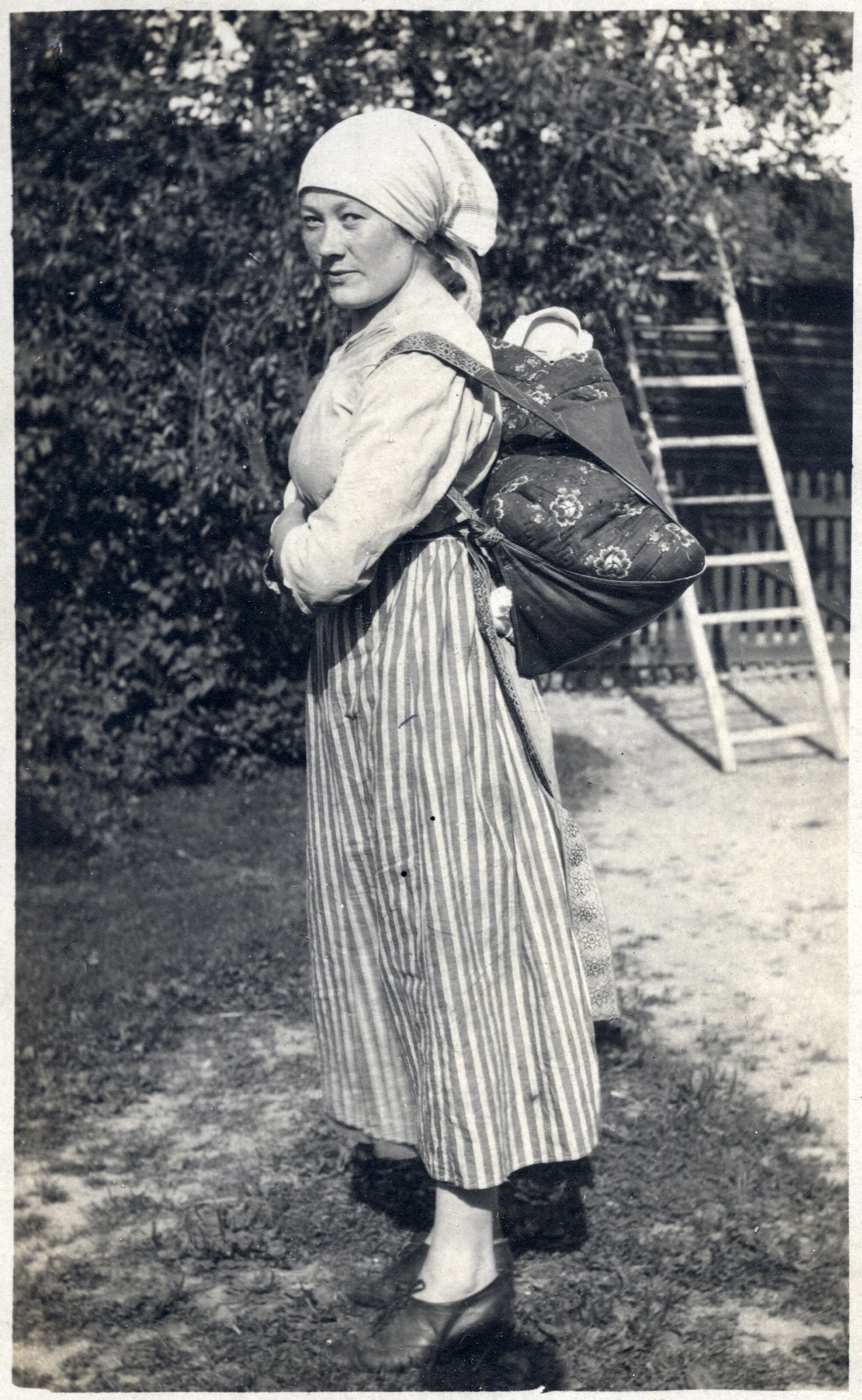
“An Immigrant’s Heart”
Leaving Sweden for whatever reason must have been very difficult for my grandmother because I’ve always known how much she loved her country and her family. She always spoke with such love and affection about those back in ‘the old country’…and I know she missed them. I wonder what the moment was like when the first thought of coming to America came to her. Her mother had died when she was 18 and as the oldest daughter, inherited her mother’s role in caring for her 6 younger siblings ranging in age from 16 to 4 years old. Together they worked along with their kind father to provide a living for the family. They were always very close and kept in close contact throughout the years. But, the day did come when at 23 years old, she boarded the ship with two small sons, an older brother (Carl) and a cousin, and on November 23, 1923, sailed to the United States on the SS Stockholm to make her new home. Her husband, Anders had gone ahead of her on July 6, 1923 [passage was taken thru Canada entering the states at Harlem, Montana.] I don’t know how they all traveled across the States to Washington on the West Coast. It was a typical immigrant pattern – one person would come, and then, like ‘tag…you’re it’, the next one would venture to come over. Eventually, over the years, Grandma’s other brother, Emil came. My grandfather’s two sisters came, also several cousins…and then begins the story of the Next Swedish Generation…my mother being born in America and here I am telling “the rest of the story” with memories, tales of tradition, family lore, and heart.
Between what I’ve heard from my mom and heard from Gramma herself, life as a young mother in a strange new land was a lesson in survival both emotionally and physically. Her fears were real. Who knew who the stranger was who came to the door? What did they want…who were they?” As a child, my mom was often told to go into a closet to not be seen when someone came to the house. English was difficult – the meat she got from the butcher one day was bad – and in frustration trying to explain the reason she brought it back, she exasperatingly told him to, “Stink it yourself”!
And when her oldest son died of appendicitis around 5 years old, no words could ever tell her sorrow…especially when the doctors wouldn’t allow her to be with him at the hospital. And no one to explain why.
But the ‘immigrant way’ was accomplished by brave hearts and what they were made of inside. My Gramma was a valiant pioneer who met life as it came. They built a home in Gate, Washington. Grandpa would leave for weeks at a time to work on the coast in the lumber industry. Grandma milked the cows, kept the garden, cleaned her home and raised their three children. Money was always an issue. Every year they had a cow that was raised for meat and one that was raised to sell. All around the neighborhood Grandma became famous for her baking and the milkman would take a day’s worth of her baking around to sell for her for $.25 a loaf. Can you imagine making bread in a huge big bowl, and mixing it all by hand? Gramma only stood about five feet tall and walked with a cane!
And was she talented! As a young girl in Sweden she learned all the homecrafts a young woman was expected to know – weaving, knitting, crocheting, embroidering, cooking, making a home, etc. (She called it her ‘fancy work’) When I was 11 or 12 years old, she began to share with me her love of these things and there were hours we spent working on projects and talking in her little home where the wind blew and the locust leaves sang.
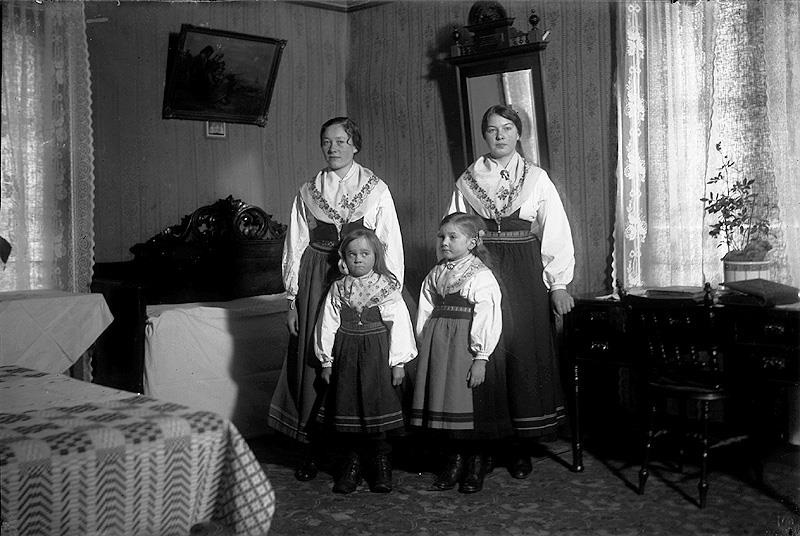
“Made In Sweden”
Life was difficult in the 1800’s – especially in the rural areas in Sweden, including my grandparents’ parish,(Mora) in Kopparberg. The resilient Swedes turned to the cottage craft industry to supplement their income to provide for their families. Each village and/or parish had particular endeavors they specialized in which consisted of old handiwork traditions…i.e., wood carving, clock making, hair plaiting, etc.
One of my relatives in Färnäs was a hair weaver….I have a picture frame that came from the old farm house attic. It is just as the historians describe with intricate flower patterns woven (with human hair) so many years ago showing what must have been hours of delicate and careful labor. It was an art that was passed on from those who were skilled to others. The village of Vamhus was particularly known for their expertise in hair plaiting. But as there was no market for the items they made, such as pictures, jewelry, keepsakes, ornaments…the villagers would divide up in small groups known as “Hår Kullor” and travel around the country to sell their items, which at the time were quite popular.
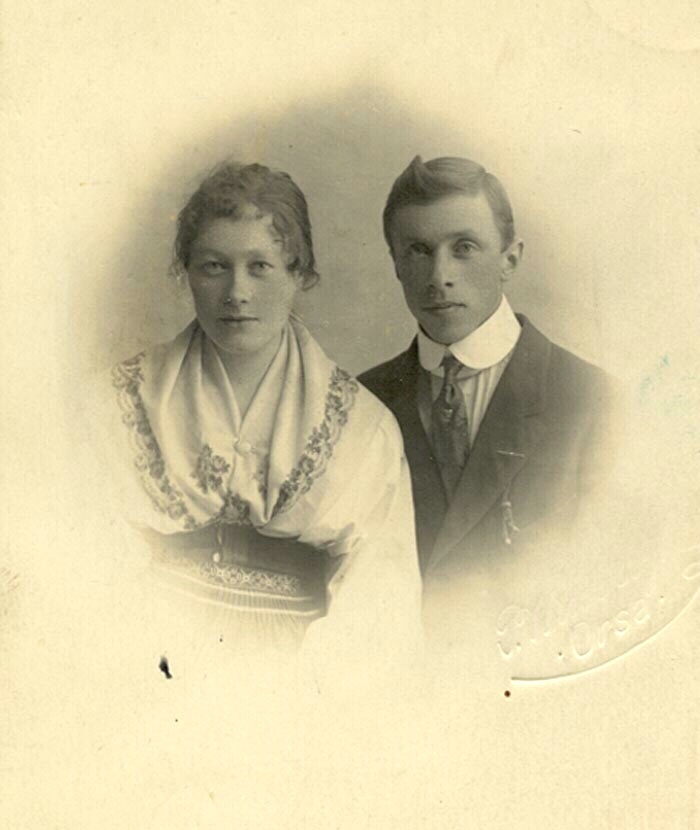
In Mora, their specialty was clock making. My grandparents had a beautiful Mora Clock which they brought over from Sweden and it was the focal point of their home. It was always a comfort to listen to as for hours my grandmother would crochet her bedspreads and tablecloths…the melodious ticking matching the rhythm of her fingers weaving the threads deftly into beautiful home furnishings and gifts. This clock is especially meaningful as my grandfather is the 3rd great grandson of Krang Anders Andersson (1726-1799) from Ostnor, Mora in Kopparberg. Krang Anders was known for his signature and quality of work in building these clocks. My grandfather was also the 2nd great grandson of Frost Mats Matsson, (1769-1848) among others as well who were involved in making clocks in Mora. Making the clocks was an effort in teamwork. Certain villages were in charge of wood cases, others the clock faces, the painting, or mechanical work. It was good while it lasted but because the middlemen began taking profits and the modernization of the craft it was not to endure. Now, however, the clocks are sought after as antiques – relics of an era, now a memory.
“Swedish Pancakes and The Great Dilemma”
When Grandma came to visit us she had one job to do…AND, when we would go and visit her…she had only one job to do. That was to make us kids lots of Swedish Pancakes! I think before she came in the house the table was set with jam and butter, syrup and bacon. Nobody could whip up those pancakes better than Gramma. With five hungry, adoring grandchildren greeting her at the door with the frying pan in hand, she came with her sleeves rolled up and an apron. She was such a great cook! How she could put such a little spoon of batter in the pan and manipulate it to form a totally round, lightly browned pancake is still a mystery to me. Who would have thought it took so much skill to truly conquer the art of making seriously perfect Swedish Pancakes? However, that definitely wasn’t on our minds as kids when the first pancake came off the griddle. We would line up in a row (practically at her elbow) holding our plates ready. The suspense and anticipation increased by the moment…so did the wonderful aroma which filled the kitchen. When the first pancake was ready, it signaled for the feast to begin. The lucky child who got the first one carefully made sure all the rest of us in line were properly envious as they carried their prize to the table. First, you had to unfold any wrinkles in it. Finger licking was acceptable, since if a little piece came off in this effort, why of course, you had to eat it. When the work of opening it up was accomplished, the great dilemma was to decide whether to put jam or syrup on it – then, carefully you rolled it up in all its glory – they tasted SO good! (Although, as I remember, my brother wasn’t that careful – his was the approach to eat quickly and get back in line before me.) One by one, Gramma cooked those pancakes as we continuously ate and returned in line again and again for one more pancake after another. Sometimes I wonder if in Heaven, Gramma knows how much I miss her and those Swedish pancake days…
“Mormor or Farmor?…It Doesn’t Really Matter”
27 years after my grandmother immigrated from Sweden, I became her fourth grandchild and she was always “My ‘Gramma'” to me…and that’s what I call her whenever I think about her. But in reality, she was my “Mormor”…my mother’s mother. Swedish children distinguish their grandparents by using the terms “Mormor and Morfar” for their grandparents on their mother’s side and “Farmor and Farfar” for their grandparents on their father’s side. And I am of the opinion that everybody should have one of each!
Carrying out that tradition our children knew their paternal grandparents as “Farmor and Farfar”. My husband and I have discovered that you ‘become of age’ when your children begin to have their families and as each child is born and is introduced to you, they announce your distinctive title depending on whether you are being introduced to your son or daughter’s child…i.e, “Kari, this is your new Mormor!” Or, “Ben, this is your new Farmor!”… (You will never be known by or called by any other name in this life or the next. They may not even ever discover you have another name!)
Well, I take that back…the name throughout the years eventually and lovingly becomes, “My Mormor” or “My Farmor”…
My job is to just keep track of who I am to who or whom?!
___________________________________________
Grandma’s own family was very loving. They adored their father and each other so much. It must have been hard for Grandma to come away to America. I can only wonder what the draw was – but I’m so glad she did. It is a blessing to have been born here and get chances for opportunities…but it comes and came with a price. Grandma was always so nice and I liked the way she smelled like Merle Norman face cream…and I laugh to remember helping her pull up her socks so she could put stretched out the rubber Kerr jar canning lids around her legs above the knees to hold them up! And bacon! No matter when or where I smell bacon I am drawn back to Gate….getting up for breakfast after spending a night there. The smell was so good and we had pancakes and Tang to drink out on the porch. The morning air was crisp and it was so quiet outside. The cows were just eating and the birds sang but not a lot of cars were out riding by that early hour. Pure memory delight! I sure love my grandmother…
